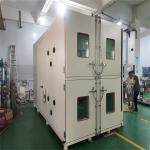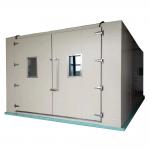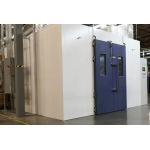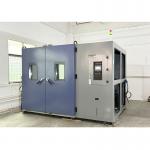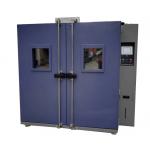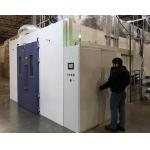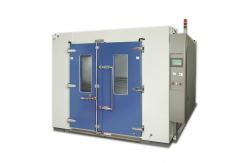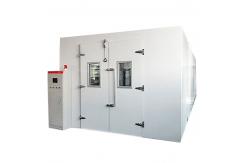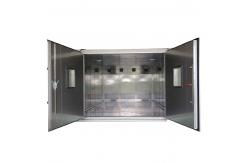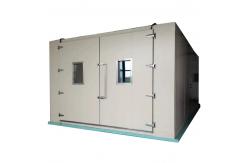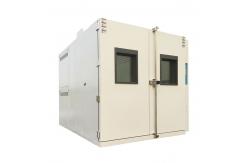In the ever-evolving landscape of research, product development,
and quality control, the Customized Walk-In Environmental Chamber
stands as a beacon of versatility and precision. This innovative
piece of equipment is designed to meet the unique and specific
requirements of a wide range of industries, providing a controlled
environment that can be finely tuned to replicate various
real-world conditions. The Customized Walk-In Environmental Chamber is a purpose-built
enclosure that allows for the simulation of different environmental
parameters within a spacious interior. It is engineered to
accommodate a diverse array of products, materials, or samples,
enabling comprehensive testing and analysis. The customization
aspect is key, as it empowers users to define the chamber's size,
temperature range, humidity levels, and other essential features
according to their particular needs. This makes it an invaluable
asset in industries such as pharmaceuticals, automotive,
electronics, food and beverage, and aerospace. For instance, in the
pharmaceutical industry, it can be used to assess the stability and
shelf life of drugs under different temperature and humidity
conditions, ensuring their efficacy and safety. In the automotive
sector, it helps in evaluating the performance and durability of
components and systems in extreme environmental scenarios. - Flexible and Durable Construction
- The chamber is constructed with high-quality materials that offer
both strength and durability. The exterior is typically made of
robust steel, providing excellent protection against physical
damage and corrosion. The interior is lined with a non-reactive and
smooth surface, which is crucial for preventing any unwanted
interactions between the chamber and the items being tested. The
modular design of the chamber allows for easy customization and
expansion. It can be configured with adjustable shelves, racks, or
hanging systems to optimize the use of space and accommodate
different sample geometries and sizes.
- The door of the chamber is engineered for a tight and reliable
seal. It features a heavy-duty hinge and a secure locking
mechanism, ensuring an airtight and watertight enclosure. The door
is also equipped with a large viewing window, usually made of
tempered glass, which enables operators to monitor the testing
process without disrupting the internal environment. The window may
have additional features such as anti-fog and UV protection,
depending on the specific application requirements.
- Precision Environmental Control Systems
- The temperature control system is highly advanced and accurate. It
can maintain a wide temperature range, which can be customized to
meet specific needs. For example, it may span from -70°C to +150°C,
with an accuracy of ±0.5°C. The system utilizes a combination of
efficient heating and refrigeration elements, along with a
sophisticated feedback loop and multiple temperature sensors
strategically placed throughout the chamber. This ensures uniform
temperature distribution and rapid temperature change capabilities,
allowing for efficient thermal cycling experiments.
- The humidity control system is equally precise. It can adjust the
relative humidity from 5% to 95% RH, with an accuracy of ±2% RH.
The chamber is equipped with a high-efficiency humidifier and
dehumidifier, which work in tandem to achieve rapid and accurate
humidity adjustments. The control panel allows for easy programming
and monitoring of humidity levels, and the system also features a
dew point control function, which is essential for testing
applications where condensation needs to be carefully managed.
- In addition to temperature and humidity, the chamber can also be
customized to control other environmental parameters such as air
pressure, gas composition, and light intensity. For example, in the
aerospace industry, it may be necessary to simulate the
low-pressure conditions of high altitudes, while in the food
industry, controlling the gas composition can help in studying the
effects of modified atmosphere packaging on product shelf life.
- Advanced Instrumentation and Data Acquisition
- The chamber is outfitted with a comprehensive suite of sensors.
Temperature sensors are distributed evenly to detect any
temperature gradients and ensure a homogeneous thermal environment.
Humidity sensors provide real-time data on the relative humidity
levels. Additional sensors for other parameters, such as pressure
sensors and gas analyzers, are also incorporated as needed. These
sensors are connected to a state-of-the-art data acquisition system
that records and stores all the measured data. The data can be
accessed and analyzed in real-time or retrieved later for in-depth
studies.
- The control panel of the chamber is user-friendly and intuitive. It
allows operators to easily set the desired environmental
parameters, program complex test sequences, and monitor the status
of the chamber and the testing process. The panel displays all the
relevant information, including current temperature, humidity, and
the status of the control systems. It also has built-in alarms and
safety features to alert operators in case of any abnormal
conditions or system failures. The data acquisition system can be
integrated with external software and databases, enabling seamless
data transfer and analysis. It can also be configured to send
notifications and reports automatically, saving time and effort for
the users.
- Volume and Dimensions: The walk-in nature of the chamber offers a large testing volume,
which can be customized to fit the specific requirements. It can
range from a few cubic meters to several tens of cubic meters. The
interior dimensions are carefully designed to optimize the
distribution of environmental parameters and ensure that all
samples are exposed to consistent conditions. The external
dimensions are also configured to fit within the available space in
a laboratory or industrial facility.
- Temperature Range: As mentioned, the temperature range can be customized, typically
from -70°C to +150°C. This wide range allows for testing a vast
array of products and materials. For example, in the electronics
industry, components can be tested under both extremely cold and
hot conditions to evaluate their performance and reliability. In
the food industry, it can simulate the temperature conditions of
refrigeration, storage, and transportation.
- Humidity Range: The relative humidity can be adjusted from 5% to 95% RH. In the
pharmaceutical and cosmetic industries, products may need to be
tested at different humidity levels to ensure their stability and
quality. High humidity can affect the solubility and potency of
drugs, while low humidity can cause drying and cracking of cosmetic
products. In the electronics industry, humidity can impact the
performance and reliability of components, such as causing
corrosion or short circuits.
- Other Parameter Ranges: If applicable, the chamber can control other parameters within
specific ranges. For example, the air pressure can be adjusted from
near-vacuum conditions to several times atmospheric pressure,
depending on the industry requirements. The gas composition can be
precisely controlled, allowing for the simulation of different
atmospheric or modified atmosphere conditions. The light intensity
can be adjusted from very low levels to high-intensity
illumination, which is useful in testing the effects of light on
materials and products, such as in the packaging and textile
industries.
- Uniformity and Stability: The temperature uniformity within the chamber is maintained
within ±1°C, ensuring that all parts of the tested samples
experience a consistent thermal environment. The humidity
uniformity is within ±3% RH. The stability of all controlled
parameters is excellent, with minimal fluctuations over time,
allowing for accurate and repeatable testing.
- Accurate Environmental Simulation
- The primary function of the Customized Walk-In Environmental
Chamber is to provide a highly accurate and realistic simulation of
specific environmental conditions. By precisely controlling
temperature, humidity, and other parameters, it allows
manufacturers and researchers to evaluate how products and
materials will behave in various real-world situations. For
example, in the development of new building materials, the chamber
can be used to test their durability and performance under
different temperature, humidity, and UV exposure conditions,
leading to the creation of more resilient and long-lasting
structures.
- The ability to create complex environmental profiles, such as
cyclic temperature and humidity changes, is also a valuable
function. This can help in identifying potential weaknesses or
failure points in products that may not be apparent under static
conditions. For instance, in the automotive industry, components
can be tested under cyclic temperature and humidity conditions to
simulate the changes they experience during different seasons and
driving conditions, ensuring their reliability and safety.
- Enhanced Product Quality and Research Capabilities
- Through comprehensive testing in the chamber, manufacturers can
identify and address potential issues in their products. For
example, if a product shows signs of degradation under high
humidity and temperature, the company can make design changes,
select different materials, or improve manufacturing processes to
enhance its resistance. This leads to the development of more
stable and reliable products, reducing the risk of failures and
recalls.
- The test chamber also serves as a powerful research tool. It allows
scientists and engineers to conduct fundamental studies on the
effects of environmental factors on new materials and technologies.
For example, in the field of materials science, the chamber can be
used to study the phase transitions and mechanical properties of
materials under different temperature and humidity conditions,
leading to the discovery of new materials with improved performance
and functionality.
- Compliance with Industry Standards and Regulations
- Many industries have strict standards and regulations regarding
product testing in specific environmental conditions. The
Customized Walk-In Environmental Chamber is a reliable tool for
ensuring compliance. For example, in the pharmaceutical industry,
products need to meet certain temperature and humidity requirements
to ensure their safety and efficacy. By using this chamber to
conduct tests in accordance with relevant standards like ICH, USP,
or GMP, manufacturers can prove that their products meet the
necessary criteria, facilitating market access and enhancing
consumer confidence.
|
